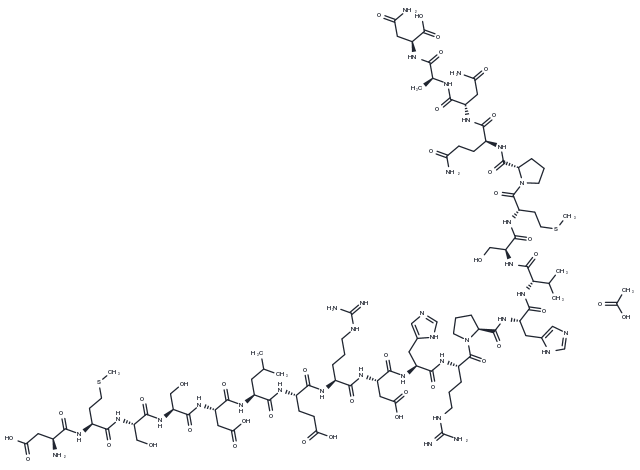keep away from moisture
Powder: -20°C for 3 years | In solvent: -80°C for 1 year

Katacalcin acetate(85916-47-8 free base) (PDN 21 acetate) is a potent plasma calcium-lowering peptide.

| Pack Size | Availability | Price/USD | Quantity |
|---|---|---|---|
| 1 mg | In stock | $ 245.00 | |
| 5 mg | In stock | $ 612.00 | |
| 10 mg | In stock | $ 869.00 | |
| 25 mg | In stock | $ 1,320.00 | |
| 50 mg | In stock | $ 1,780.00 | |
| 100 mg | In stock | $ 2,380.00 |

| Description | Katacalcin acetate(85916-47-8 free base) (PDN 21 acetate) is a potent plasma calcium-lowering peptide. |
| In vitro | Katacalcin is a potent plasma calcium lowering peptide. Katacalcin belongs to the calcitonin family, that causes a rapid but short-lived drop in the level of calcium and phosphate in blood by promoting the incorporation of these ions in the bones[1]. Katacalcin (KC) belongs to a small family of polypeptides that are encoded by the calc-1 gene and also include calcitonin (CT) and procalcitonin NH2-terminal cleavage peptide (N-ProCT). Katacalcin pretreatment leads to a concentration-dependent decrease at concentrations between 1 amol/liter and 10 fmol/liter and is a more potent inhibitor of fMLP-induced chemotaxis than CT or procalcitonin (PCT). Katacalcin deactivates CD14+ peripheral blood mononuclear cell (PBMC) chemotaxis not only toward N-formyl-Met-Leu-Phe (fMLP) but also toward other attractants of the chemokine family (heterologous deactivation) as well as toward PCT and CT. Pretreatment of CD14+ PBMCs with Katacalcin also deactivates subsequent chemotaxis toward Katacalcin itself. Katacalcin elicites concentration-dependent migration of CD14+ PBMC at concentrations from the atomolar to the micromolar range and deactivates attractant-induced chemotaxis. Katacalcin regulates human CD14+ PBMC migration via signaling events involving protein kinase A-dependent cAMP pathways[2]. |
| Synonyms | PDN 21 acetate |
| Molecular Weight | 2496.65 |
| Formula | C99H158N34O38S2 |
| CAS No. | TP1062L |
keep away from moisture
Powder: -20°C for 3 years | In solvent: -80°C for 1 year
DMSO: 10 mM
You can also refer to dose conversion for different animals. More
bottom
Please see Inhibitor Handling Instructions for more frequently ask questions. Topics include: how to prepare stock solutions, how to store products, and cautions on cell-based assays & animal experiments, etc.
Katacalcin acetate(85916-47-8 free base) TP1062L Others PDN 21 Acetate PDN-21 Acetate Katacalcin acetate(85916478 free base) PDN21 Acetate PDN 21 acetate Katacalcin acetate(85916 47 8 free base) inhibitor inhibit
